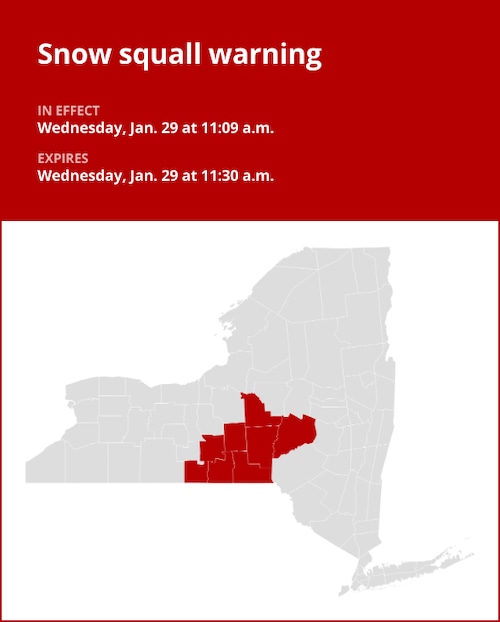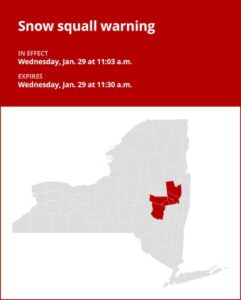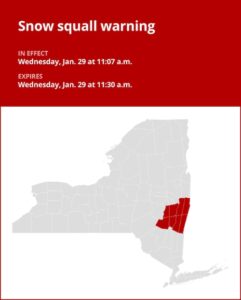On Wednesday at 11:09 a.m., the National Weather Service issued a snow squall warning for Broome, Chemung, Chenango, Cortland, Madison, Otsego, Tioga, and Tompkins counties, which was in effect until 11:30 a.m.
“At 11:08 a.m., a dangerous snow squall was located along a line extending from near Springfield to near Norwich to near Berkshire to near Chemung to near Millerton, moving east at 40 mph,” according to the meteorological service. “Travel will become difficult and potentially dangerous within minutes.”
Chemung, Binghamton, Elmira, Vestal, Cortland, Johnson City, Oneonta, Endicott, Southport, and Barton are among the places affected by the notice.
Additionally, the weather service says, “Slow down and switch on your headlights! Whiteout situations during snow squalls can cause visibility to abruptly plummet to almost nothing. Think about staying put or postponing your trip till the snowstorm has passed. If you have to travel, be especially careful and give yourself more time. Accidents may result from sloppy roads and abrupt changes in visibility.
Strong bursts of heavy snow are one of the hazards. Visibility quickly drops to less than a quarter mile due to gusty winds that cause snow to fly. Tree limbs could be toppled and unsecured objects could be blown around by wind gusts exceeding fifty miles per hour.
Navigating snow squalls: Understanding, preparing, and staying safe
What are snow squalls?
Strong cold fronts are frequently associated with snow squalls, which are short but intense winter weather phenomena. Even in the absence of a significant winter storm, they can quickly result in icy roads and unexpected whiteout conditions. Even while they often last less than an hour and may only cause slight snow accumulation, their reduced visibility, strong winds, and quickly dropping temperatures make them extremely dangerous for driving. In the past, these circumstances have resulted in fatal traffic accidents.
Understanding snow squalls vs. Snowstorms
The length of the event distinguishes a snowstorm from a snow squall. Typically lasting between 30 and 60 minutes, snow squalls are incredibly powerful. Days or even hours may pass during a snowfall.
Snow squall warnings
Like warnings for tornadoes or severe thunderstorms, snow squalls are quickly issued for specific locations. They provide vital, locally relevant information that can save lives. If there is a snow squall warning in your location, it is recommended to wait until the squall passes before driving.
Actions to take
When a snow squall warning is issued, people should heed the weather service’s instructions, which include the following crucial steps:
Avoid or postpone travel: It is best to wait until the snow squall has gone through your area before driving if a snow squall warning has been issued for your area. During snow squalls, roadways and highways are especially dangerous.
Decrease speed and improve visibility: If you are already traveling and won’t be able to get off the road in time, slow down and activate your headlights and hazard lights.
Keep a safe distance by giving the automobile in front of you plenty of space.
Steer clear of sudden braking: It’s also best to avoid applying the brakes too hard. This could lead to a loss of vehicle control and raise the possibility of a chain reaction collision on slick or icy roads.
Winter weather safety advice: Go to the weather service’s Winter Weather Safety page for detailed instructions on how to keep safe before, during, and after experiencing winter weather. This website provides helpful advice and safety measures to assist you successfully deal with the difficulties presented by winter weather.
Get your car ready:Make sure your car is winter-ready before you hit the road this winter by checking the tires, brakes, lights, and making sure all the fluids are at the right levels. A well-maintained car can handle the rigors of winter roads more easily.
Important supplies for your car’s emergency kit: Make sure your car has a complete emergency kit that includes necessities like blankets, water, non-perishable food, a flashlight, and a first aid kit. To improve tire traction, don’t forget to have jumper cables, flares or a reflective triangle, ice scraper, a map, a car cell phone charger, and cat litter or sand. In the event of an emergency or unplanned breakdown while traveling, these provisions may prove to be quite beneficial.
In conclusion, putting one’s own safety first and following the weather service’s advice can greatly reduce dangers when a snow squall warning is in effect. People can travel through these winter dangers with more assurance and security if they are aware of them, plan beforehand, and remain alert.
United Robots offers a service called Advance Local Weather Alerts that gathers the most recent information from the National Weather Service using machine learning.






+ There are no comments
Add yours